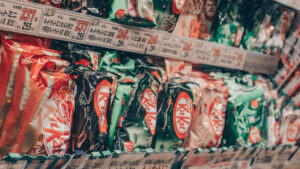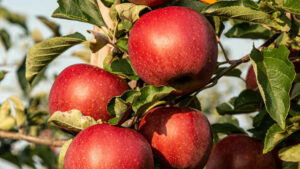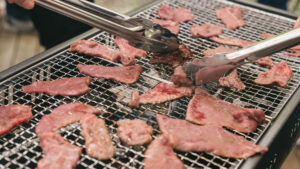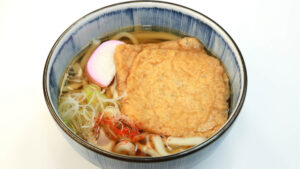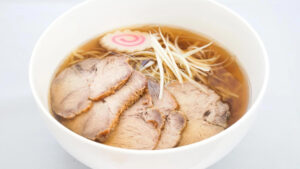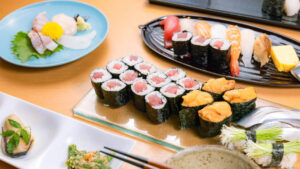Contents
What Is Gotouchi Gourmet? The Unique Appeal of Japan’s Local Food Culture
If you’re traveling in Japan, you can’t miss the “gotouchi gourmet”—local dishes that reflect the region’s climate and culture. These foods offer a special experience that can only be enjoyed in each specific area. In this article, we’ll introduce the basics of what gotouchi gourmet is, along with some of Japan’s most iconic local dishes.
What Is Gotouchi Gourmet?
Locally Created Cuisine
Gotouchi gourmet refers to dishes that were born in a specific region and have long been loved by the local people. These meals often use local ingredients, seasonings, and reflect the region’s history and customs. They are known for being something you can only taste in that particular place—and that’s exactly what makes them special.
Local Food Loved by Travelers
In recent years, locally developed specialty dishes have become popular not only among residents but also among travelers. These include station bentos, street food, and menu items exclusive to certain tourist spots. Increasingly, they are being featured as a key reason to visit a place. Many local governments and tourism associations are even developing such dishes to promote their region, making gotouchi gourmet an essential part of the travel experience in Japan.
Difference from “B-Class Gourmet”
The term “B-class gourmet” refers to inexpensive but tasty everyday dishes, often overlapping with gotouchi gourmet. However, B-class gourmet mainly emphasizes affordability and familiarity. Events like the “B-1 Grand Prix” introduce regional specialties under this category. In contrast, gotouchi gourmet is a broader concept that can also include dishes made with premium ingredients or those closer to traditional cuisine.
Difference from Traditional Local Cuisine
While gotouchi gourmet and traditional local cuisine (kyōdo ryōri) are similar, they differ in key ways. Kyōdo ryōri refers to traditional home-cooked dishes passed down for generations within a region. Gotouchi gourmet, on the other hand, often includes newer creations aimed at tourists or products developed by local businesses. In other words, kyōdo ryōri is “traditional,” while gotouchi gourmet represents “new regional specialties” created for local revitalization.
The Origins of Gotouchi Gourmet
Food Culture Shaped by Geography and Climate
Japan stretches long from north to south and experiences distinct seasons, resulting in significant regional differences in geography and climate. Coastal areas naturally developed rich seafood-based cuisines, while mountainous regions created food traditions focused on preserved items and wild vegetables. These natural factors gave rise to the diverse local food cultures found across the country.
Regional Branding Through Tourism Development
Since the 1970s, as domestic tourism boomed, regions across Japan began to emphasize their unique identities as travel destinations. Gotouchi gourmet, using local specialties and ingredients, emerged as a powerful branding tool. Dishes like regional burgers and specialty curries with a strong local twist became popular attractions, drawing attention from tourists and media alike.
Regional Differences in Taste Preferences
Japan has notable regional differences in flavor preferences. For example, Kansai tends to favor lighter seasoning, while Kanto prefers stronger, saltier flavors. These differences extend to the types of sauces and broths used in cooking. Such variations in regional tastes have led to the rich diversity found in gotouchi gourmet across the country.
Why Gotouchi Gourmet Is So Popular
Local Food Culture Even Japanese Don’t Always Know
Many gotouchi gourmet dishes are known only within limited regions—even among Japanese people. For travelers, this offers the chance to discover hidden culinary gems and experience a lesser-known side of Japanese culture. It’s a unique and authentic adventure that goes beyond the typical tourist experience.
An Engaging, Hands-On Cultural Experience
Gotouchi gourmet is more than just food—it’s an experience. Talking with local shop owners, enjoying the atmosphere of a neighborhood eatery, and watching meals prepared right in front of you all contribute to a deeper connection with the region. These interactions turn a simple meal into a lasting travel memory.
A Journey Through Japan’s Gotouchi Gourmet: Regional Guide
Hokkaido & Tohoku Region
Sapporo’s Soup Curry and Jingisukan
When it comes to local food in Sapporo, two iconic dishes stand out: spicy soup curry and lamb barbecue known as “Jingisukan.” Soup curry features a light, broth-like curry served with vegetables and meat, offering a unique twist on traditional Japanese curry. Jingisukan is a grilled lamb dish, cooked on a dome-shaped iron grill and eaten hot off the pan—perfect for sharing and warming up in the cold Hokkaido climate.
Sendai’s Grilled Beef Tongue
Sendai is famous for its grilled beef tongue, or “gyūtan-yaki.” Thick slices of beef tongue are charcoal-grilled to enhance their savory flavor and chewy texture. They’re typically served with barley rice and oxtail soup, forming a well-balanced local set meal. The city’s “Gyūtan Street,” lined with specialty restaurants, is a must-visit spot for food lovers.
Kiritanpo Hot Pot from Akita
Kiritanpo nabe is a traditional hot pot dish from Akita Prefecture, featuring “kiritanpo”—freshly cooked rice mashed, shaped around wooden sticks, and grilled over charcoal for a toasty flavor. These rice sticks are then simmered in a chicken-based broth along with ingredients like burdock root, maitake mushrooms, seri (Japanese parsley), and konnyaku. It’s a warm, comforting dish especially popular during the autumn and winter seasons.
Kanto & Chubu Region
Utsunomiya and Hamamatsu Gyoza
Utsunomiya and Hamamatsu are two of Japan’s most famous gyoza cities. Utsunomiya gyoza is known for its light flavor, with plenty of vegetables like Chinese cabbage, making it refreshing and easy to eat.
Hamamatsu gyoza, on the other hand, contains more cabbage and onions as well as a generous amount of meat. Its signature presentation is a circular arrangement of gyoza with a mound of bean sprouts placed in the center—a unique local style that sets it apart.
Nagoya’s Miso Culture (Miso Katsu and Miso Nikomi Udon)
Aichi Prefecture is famous for its unique red miso culture. Miso katsu is a dish where a crispy pork cutlet is topped with a rich, savory red miso sauce—perfectly paired with steamed rice. Miso nikomi udon features thick udon noodles simmered in a clay pot with a deeply flavored miso broth, making it an ideal comfort food for cold winter days.
Toyama Black Ramen
Originating in Toyama Prefecture, Toyama Black Ramen is known for its jet-black soy sauce-based soup. Despite its bold appearance, the flavor is rich, salty, and full-bodied. The broth’s strong seasoning makes it perfect to enjoy with a bowl of rice—a common local practice. Its unique look and intense flavor have made it a popular dish on social media as well.
Kansai, Chugoku & Shikoku Region
Osaka’s Flour-Based Food Culture (Takoyaki and Okonomiyaki)
Osaka is the heart of Japan’s flour-based food culture, known as “konamono.” Two of its most iconic dishes are takoyaki and okonomiyaki. Takoyaki are ball-shaped snacks with a crispy outside and soft, gooey inside, filled with pieces of octopus—commonly sold at street stalls. Okonomiyaki is a savory pancake made by grilling a batter of cabbage, pork, and other ingredients, topped with sweet sauce and mayonnaise. Both are beloved by locals and tourists alike for their casual, friendly appeal.
Hiroshima-Style Okonomiyaki
Hiroshima-style okonomiyaki differs significantly from the Kansai version in both ingredients and cooking method. While the Kansai style mixes all ingredients into a batter before grilling, Hiroshima-style layers each component—batter, cabbage, noodles, and toppings—on top of one another and grills them in that stacked form. The result is a hearty, visually striking dish that showcases a unique regional identity.
Tokushima Ramen and Sudachi Cuisine
Tokushima ramen features a distinctive topping of sweet and savory pork belly and a raw egg, creating a rich and flavorful bowl. Tokushima is also known as a major producer of sudachi, a small citrus fruit. Many local dishes and drinks use sudachi to add a refreshing, tangy flavor—especially popular in the hot summer months.
Recommended Ways to Experience Gotouchi Gourmet
Visit Local Food Stalls and Markets
Explore Local Markets
Markets not listed in tourist guides are where locals do their daily shopping and offer a more authentic, affordable gotouchi gourmet experience. Unlike restaurants in tourist areas, these markets showcase the everyday flavors of the region. Visiting them lets you truly feel the local food culture and lifestyle up close.
A Chance to Talk with Locals
If you can speak some Japanese, asking for food recommendations or inquiring about how dishes are prepared can lead to deeper interactions during your trip. Conversations like these add a personal touch to your journey and often become some of the most memorable moments.
How to Navigate Restaurants Without English Menus
It’s common for small local eateries not to have English menus, but that’s part of the adventure. You can simply point at photos on the menu, or use a translation app in advance to feel more confident. Checking reviews and food photos on Google Maps beforehand is also a smart way to know what to expect.
Highway Rest Stops and “Michi-no-Eki” for Local Gourmet
Local Specialties at Michi-no-Eki
“Michi-no-Eki” (roadside stations) are rest areas that offer local produce, specialty products, and meals made with regional ingredients. They’re perfect for a quick and delicious break while traveling, and a great place to sample dishes you can only find in that area. From full meal sets to light snacks, the variety is wide and satisfying.
Regional Soft-Serve Ice Cream
At michi-no-eki and highway service areas, local soft-serve ice cream made with regional specialties is a big hit. You can enjoy unique flavors like Yubari melon (Hokkaido), wasabi (Shizuoka), or soy sauce (Chiba). With so many varieties to choose from, discovering how they actually taste is part of the fun.
Perfect for Road Trips
Michi-no-eki and service areas are ideal stops for travelers on road trips. They offer more than just rest—they’re hubs for meals, local info, and refreshment. Many feature large parking lots, clean restrooms, and even tourist information centers, making long-distance travel more comfortable and convenient.
Great Places to Find Souvenirs
These roadside facilities also sell a wide selection of local specialties and original products, making them perfect for souvenir shopping. From sweets and sauces to regional goods and crafts, there’s plenty to explore. Many spots even offer free samples, so you can taste before you buy.
Using Food Maps and Tourist Guides
Check Local Tourism Websites in Advance
Many local governments share gourmet information through their official tourism websites. You can also find the latest updates on seasonal ingredients and upcoming food events, making it easier to plan your culinary adventures before your trip.
Get the Latest Tips at Tourist Information Centers
Tourist information centers located at train stations, airports, and major attractions offer free paper maps and brochures featuring local gourmet spots. Staff members can also provide personal recommendations. In rural areas especially, they may even share hidden gems known only to locals—valuable insider info that you won’t find online.
Gotouchi Gourmet and Regional Revitalization
The B-Class Gourmet Boom
The Birth of the “B-1 Grand Prix”
Launched in 2006, the “B-1 Grand Prix” is a nationwide event where regions compete by showcasing their best B-class gourmet dishes—affordable, everyday comfort foods. The event attracts large crowds from across Japan and has helped many previously unknown local dishes gain national recognition. For many towns, it has been a turning point in boosting tourism and local pride.
Collaborating with Tourism Promotion
Gotouchi gourmet is increasingly used as a tool in tourism strategies. By featuring food prominently in posters, commercials, and travel promotions, regions can spark interest among potential visitors. Events like ekiben (station bento) fairs and michi-no-eki food festivals are held nationwide, using local cuisine as a central theme to draw in travelers.
A Symbol of Local Pride
For many communities, gotouchi gourmet is more than just food—it’s a symbol of their identity and cultural heritage. These dishes often appear at local events and even in school lunches, becoming part of everyday life. They are passed down through generations and proudly shared with outsiders, fostering a strong sense of belonging and love for one’s hometown.
Regional Branding Strategies Using Gotouchi Gourmet
Promoting the Appeal of Local Products
Gotouchi gourmet plays a key role in regional branding by showcasing local ingredients and culture. By developing menus that highlight regional resources such as agricultural and seafood products, areas can create strong associations like “this dish represents this place,” thereby increasing the perceived value of local specialties.
Collaborating with Mascot Characters
More and more regions are promoting their gotouchi gourmet alongside local mascot characters, known as “yuru-chara.” Featuring these mascots on product packaging and advertisements attracts attention from children and families, helping to create a friendly and approachable brand image that resonates with a broad audience.
Developing Instagram-Worthy Dishes
In today’s social media-driven world, visual impact is directly tied to how widely something spreads online. That’s why many regions are focusing on developing gotouchi gourmet that’s eye-catching and photogenic. Colorful presentation, unique shapes, and visually striking storefronts all contribute to creating dishes that are more likely to be shared on platforms like Instagram—boosting nationwide awareness and buzz.
Gotouchi Gourmet: A Delicious Reason to Travel
Discover Local Culture Through Food
Local dishes that can only be found in a specific region are packed with the area’s climate, history, and culture. Gotouchi gourmet is more than just a meal—it serves as a gateway to understanding the unique character of a place.
The Joy of Finding Your Favorite Flavors
All across Japan, there are still many undiscovered gourmet delights. Even outside of famous tourist spots, small towns offer incredible local dishes. The thrill of finding your own personal favorite flavor is one of the most exciting parts of traveling.
Let Food Be Your Next Travel Destination
Instead of choosing your travel destination just for the sights, why not go somewhere just to eat a specific dish? Whether it’s from a guidebook or a trending post on social media, let that one mouthwatering meal inspire your next adventure.


